PENGGUNAAN OMNI DIRECTIONAL WHEELS 4-AXIS DALAM PERGERAKAN ROBOT MAZE-SOLVING
DOI:
https://doi.org/10.51804/mmej.v7i2.16851Keywords:
Robot omni-directional, roda omni 4-axis, robot penyelesaian labirin, navigasi adaptif, algoritma kontrol robot, efisiensi motor DCAbstract
Penelitian ini membahas pengujian kemampuan robot berbasis roda omni 4-axis dalam menyelesaikan labirin dengan tingkat kesulitan yang bervariasi. Robot diuji pada empat konfigurasi utama labirin, mulai dari lintasan sederhana hingga lintasan kompleks yang memiliki elemen loop. Parameter yang diamati meliputi durasi penyelesaian lintasan, konsumsi daya, tingkat akurasi navigasi, dan jumlah koreksi jalur selama proses navigasi. Hasil menunjukkan bahwa pada lintasan sederhana, waktu rata-rata penyelesaian mencapai 12,3 detik dengan akurasi 98,8%, sedangkan pada lintasan kompleks dengan loop, waktu meningkat menjadi 58,6 detik dengan akurasi menurun hingga 89,5%. Selain pengujian navigasi, studi ini juga mengevaluasi pola gerakan robot berdasarkan sudut arah tertentu. Hasil pengujian menunjukkan pola rotasi motor yang sesuai dengan desain sistem, dengan kecepatan stabil sebesar 300 RPM. Efisiensi motor mencapai nilai tertinggi (87%) pada gerakan maju, namun sedikit menurun pada manuver geser dan diagonal. Penggunaan roda omni 4-axis memungkinkan robot bergerak lebih fleksibel di lintasan berbelok tajam atau pada konfigurasi lintasan yang memerlukan gerakan lateral. Meskipun sistem ini menunjukkan kinerja yang baik, terdapat tantangan yang perlu diatasi, termasuk kebutuhan untuk menyempurnakan algoritma navigasi agar lebih responsif dan efisien. Dengan integrasi teknologi kontrol mutakhir, sistem ini berpotensi untuk diterapkan dalam skenario robotika yang lebih kompleks, seperti eksplorasi otomatis dan operasi industri.
References
Campion, G., Bastin, G., & d'Andrea-Novel, B. (1996). Structural properties and classification of kinematic and dynamic models of wheeled mobile robots. IEEE Transactions on Robotics and Automation, 12(1), 47–62.
Das, A., & Kumar, P. (2018). Design and control of an omnidirectional mobile robot for autonomous navigation. International Journal of Robotics and Automation, 33(3), 214–223.
LaValle, S. M. (2006). Planning Algorithms. Cambridge University Press.
Nakamura, T., & Yoshikawa, T. (1991). Motion control of an omnidirectional and holonomic wheeled mobile robot. Advanced Robotics, 6(1), 47–63.
Seaman, S., & Williamson, M. (2017). Implementation of PID control in omni-directional robots for trajectory tracking. Robotics and Autonomous Systems, 89, 45–56.
Sham, M. K., & Ma, W. S. (2019). Energy-efficient path planning for autonomous robots in dynamic environments. Robotics and Computer-Integrated Manufacturing, 60, 16–25.
Dudek, G., & Jenkin, M. (2010). Computational Principles of Mobile Robotics. Cambridge University Press.
Tcho?, K., & Lisowski, W. (2013). Kinematics and control of omnidirectional robots: A tutorial. Journal of Automation, Mobile Robotics & Intelligent Systems, 7(4), 12–20.
Kumar, S., & Pratihar, D. K. (2011). Forward and inverse kinematics models for wheeled mobile robots. Robotics and Autonomous Systems, 59(3–4), 233–246.
Zhang, H., & Wang, X. (2014). Design and trajectory planning of an omnidirectional wheeled robot for indoor applications. In Proceedings of IEEE International Conference on Robotics and Automation (pp. 2356–2361).
Luo, C., & Meng, Q. (2013). Path planning for mobile robots in dynamic environments using an adaptive algorithm. Control Engineering Practice, 21(8), 1093–1102.
Nguyen, H. T., & Kang, H. J. (2019). Sensor-based navigation for omni-directional robots using hybrid control strategies. Sensors, 19(9), 2067.
Siciliano, B., & Khatib, O. (2016). Springer Handbook of Robotics. Springer.
Borenstein, J., Everett, H. R., & Feng, L. (1996). Navigating mobile robots: Systems and techniques. A. K. Peters/CRC Press, 41–56.
Thrun, S., Burgard, W., & Fox, D. (2005). Probabilistic Robotics. MIT Press.
Downloads
Published
Issue
Section
License
Copyright (c) 2025 Mechonversio: Mechanical Engineering Journal

This work is licensed under a Creative Commons Attribution-ShareAlike 4.0 International License.
With the receipt of the article by MMEJ Editorial Board and the decision to be published, the copyright regarding the article will be transferred to MMEJ. The copyright transfer form can be downloaded here.
MMEJ has the right to multiply and distribute the article and every author is not allowed to publish the same article that was published in this journal.
MMEJ is licensed under a Creative Commons Attribution-ShareAlike 4.0 International License.
Under the following terms:
Attribution — You must give appropriate credit, provide a link to the license, and indicate if changes were made. You may do so in any reasonable manner, but not in any way that suggests the licensor endorses you or your use.
ShareAlike — If you remix, transform, or build upon the material, you must distribute your contributions under the same license as the original.




